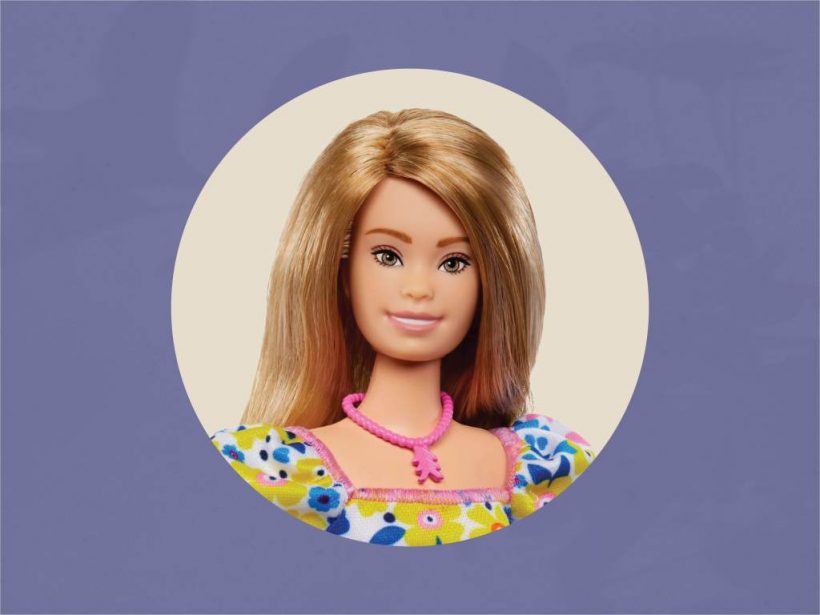Mattel’s 2023 Barbie Fashionistas line is expanding with the history-making addition of the brand’s first-ever doll with Down syndrome, marking a massive milestone in the pursuit of a more inclusive and equitable world.
On Tuesday, the toy manufacturer announced the debut of the new doll, which was “created to allow even more children to see themselves in Barbie, as well as have Barbie reflect the world around them” and “to inspire all children to tell more stories through play,” according to a press release detailing the product launch.
The Fashionistas line was launched in 2020 with the goal of “adding more diversity for endless storytelling possibilities,” per Mattel. The brand designed nearly 200 dolls, a mixture of male and female, representing 9 body types, 35 skin tones, and 97 hairstyles, as well as dolls living with various disabilities and conditions, including dolls using wheelchairs and prosthetics, and a doll with vitiligo. Mattel’s Barbie with Down syndrome is the latest addition to the diverse Fashionistas line, and the groundbreaking doll is now shoppable at major retailers for $10.99.
Barbie Fashionistas Doll with Down Syndrome$10.99on Amazon.comBuy now
-
Collaborating With the National Down Syndrome Society (NDSS)

Image Credit: Mattel. Mattel partnered with the National Down Syndrome Society (NDSS) to “ensure the doll accurately represents a person with Down syndrome,” according to the release.
The brand explained that the organization’s “guidance and real-world experiences informed the design process from start to finish, including the doll’s sculpt, clothing, accessories and packaging.”
The press release also asserted that the collaboration “ensured the Barbie team celebrated individuals with Down syndrome through a doll that would immediately connect with the community.”
Kandi Pickard, the president and CEO of NDSS, said, “It was an honor working with Barbie on the Barbie doll with Down syndrome. This means so much for our community, who for the first time, can play with a Barbie doll that looks like them.”
She added, “This Barbie serves as a reminder that we should never underestimate the power of representation. It is a huge step forward for inclusion and a moment that we are celebrating.”
-
Incorporating Meaningful Design to Represent the Down Syndrome Community

Image Credit: Mattel. Mattel worked with the NDSS to not only create a doll that physically represents the attributes of people with Down syndrome but also features design elements that are symbolic of the community.
“This doll introduces a new face and body sculpt to be more illustrative of women with Down syndrome, including a shorter frame and a longer torso,” Mattel explained. “The new face sculpt features a rounder shape, smaller ears, and a flat nasal bridge, while the eyes are slightly slanted in an almond shape. The doll’s palms even include a single line, a characteristic often associated with those with Down syndrome.”
The toy manufacturer added, “The Barbie Fashionista doll with Down syndrome also wears pink ankle foot orthotics (AFOs) to match her outfit and her sneakers tout a zipper detail. Some children with Down syndrome use orthotics to support their feet and ankles, and NDSS provided a box of orthotics to serve as real-life inspiration for the ones this Barbie Fashionista is wearing, matched to her outfit and the bright colors in her design.”
Symbolism is even woven through the Barbie doll’s clothing and jewelry. “The doll’s puff-sleeved dress pattern features butterflies and yellow and blue colors, which are symbols and colors associated with Down syndrome awareness,” Mattel said.
The brand continued, “The doll’s pink pendant necklace with three upward chevrons represents the three copies of the 21st chromosome, which is the genetic material that causes the characteristics associated with Down syndrome. The three chevrons, or arrows, are a symbol that unites the Down syndrome community and are meant to represent ‘the lucky few’ who have someone with Down syndrome in their life.”
-
The Importance of Representation During Early Childhood

Image Credit: Mattel. According to the Centers for Disease Control and Prevention (CDC), approximately one in every 700 babies in the U.S. is born with Down syndrome, comprising about 6,000 babies per year. Although the chromosomal condition is one of the most common genetic abnormalities, there aren’t any firm statistics on the worldwide Down syndrome population.
Lisa McKnight, Mattel’s Executive Vice President and Global Head of Barbie & Dolls, said of the potential global impact of the brand’s new doll, “Doll play outside of a child’s own lived experience can teach understanding and build a greater sense of empathy, leading to a more accepting world.”
She added, “We are proud to introduce a Barbie doll with Down syndrome to better reflect the world around us and further our commitment to celebrating inclusion through play.”
This doll isn’t Mattel’s first effort at inclusion; their “Barbie Fashionistas” line features a doll who uses a wheelchair, a doll with the skin condition vitiligo, a doll who uses hearing aids, and more. In 2016, Lego introduced a wheelchair-using mini-figure, but other than these two major companies in the toy industry, the world has yet to see representation in children’s play items at a mainstream level. Cheers to Mattel for being at the forefront of the effort — we can’t wait to see what they have in store for the future.
Source: Read Full Article







